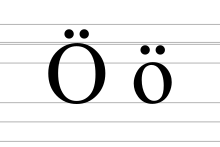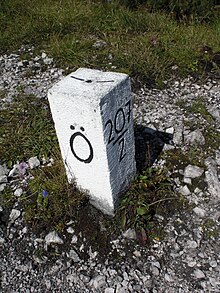Ö
This articleneeds additional citations forverification.(July 2024) |
| O with Diaeresis | |
|---|---|
| Öö | |
 | |
| Usage | |
| Writing system | Latin script |
| Type | Alpha betic |
| Language of origin | German |
| Sound values | |
| InUnicode | U+00D6, U+00F6 |
| History | |
| Development | |
| Other | |
Ö,orö,is a character that represents either a letter from several extended Latin Alpha bets, or the letter "o"modified with anumlautordiaeresis.Ö, or ö, is a variant of the letterO.In many languages, the letter "ö", or the "o" modified with anumlaut,is used to denote theclose-oropen-midfront rounded vowels[ø]or[œ].In languages without such vowels, the character is known as an "owithdiaeresis"and denotes a syllable break, wherein its pronunciation remains an unmodified[o].
O-umlaut[edit]

The letterowithumlaut(ö[1]) appears in theGerman Alpha bet.It represents the umlauted form ofo,resulting in[œ]or[ø].The letter is oftencollatedtogether withoin the German Alpha bet, but there are exceptions which collate it likeoeorOE.The letter also occurs in some languages that have adopted German names or spellings, but it is not normally a part of those Alpha bets. In Danish and Norwegian,öwas previously used in place oføin older texts to distinguish betweenopen and closedö-sounds. It is also used when confusion with other symbols could occur, on maps for instance. The Dano-Norwegianøis, like the Germanö,a development ofoeand can be compared with the Frenchœ. In other languages that do not have the letter as part of the regular Alpha bet or in limitedcharacter setssuch asASCII,o-umlaut is frequently replaced with thedigraphoe.For example, Germanhören(hear/listen) can be easily recognized even if spelledhoeren.
Öin other languages[edit]
The letteröalso occurs in two otherGermanic languages:SwedishandIcelandic,but it is regarded there as a separate letter, not as an orthographic variation of the lettero.Apart from Germanic languages, it occurs in theUralic languagessuch asFinnish,Karelian,Veps,Estonian,Southern Sami,andHungarian,in theTurkic languagessuch asAzeri,Turkish,Turkmen,Uyghur(Latin script),Crimean Tatar,Kazakh,and in theUto-Aztecan languageHopi,where it represents thevowelsounds[ø,œ].Its name inFinnish,Swedish,Icelandic,Estonian,Azeri,Turkish,Turkmen,Uyghur,Crimean Tatar,Hungarian,VoticandVolapükisÖö[øː],not "O with two dots" since/ø/is not a variant of the vowel/o/but a distinct phoneme.
In mountain dialects ofEmilian,it is used to represent[ø],e.g.tött[tøtː]"all".
In the Germanic language ofLimburgish,the (ö) is used for the short/œ/,similarly to German.
In certain languages, the letteröcannot be written as "oe" becauseminimal pairsexist betweenöandoe(and also withoo,ööandöe), as in Finnisheläinkö"animal?" (interrogative) vs.eläinkoe"animal test" (cf.Germanic umlaut). If the characteröis unavailable,ois substituted and context is relied upon for inference of the intended meaning. In Volapük,öcan be written asoy,but never asoe.
InRomagnol,öis used to represent[ɔə~ɔː],e.g.cöt[kɔət~kɔːt]"cooked".
In theSeneca language,öis used to represent[ɔ̃],a back mid rounded nasalized vowel.
In Swedish, the letteröis also used as the one-letter word for anisland,which is not to be mixed with the actual letter.Öin this sense is also a Swedish-language surname.[2]
In theSeri language,öindicates thelabializationof the previous consonant, e.g.cöihiin/kʷiˈɁiin/"sanderling".
Alphabetical position[edit]
In some Alpha bets it iscollatedas an independent letter, sometimes by placing it at or near the end of the Alpha bet, such as afterZ,ÅandÄin Swedish and Finnish, afterÝ,(Z),ÞandÆin Icelandic, and afterV,(W),ÕandÄin Estonian (thus fulfilling the place ofOmega,for example in the Finnish expressionaasta ööhön"from A to Z", literally "from A to Ö". However, in Hungarian, and in theTurkish Alpha betand otherTurkic Alpha betsthat haveö,it is an independent letter betweenoandp.
O-diaeresis[edit]
Owithdiaeresisoccurs in several languages that use diaereses. In these languages the letter represents the fact that thisois the start of a new vowel (e.g. in theDutch/Afrikaanswordcoöperatief[cooperative]), instead of the generaloo(e.g. In theDutchworddoorn[thorn]).
In English[edit]
Some writers and publications, such asThe New Yorker,use it in English words such aszoölogyandcoöperateto indicate that the second vowel is pronounced separately. It is also employed in names such asLaocoön,Coös County,and theconstellationBoötes.This is also done inDutch.
Usage in phonetic Alpha bets[edit]

In theRheinische Dokumenta,a phonetic Alpha bet for manyWest Central German,theLow Rhenish,and few relatedvernacularlanguages,örepresents theclose-mid front rounded vowelwith theIPAnotation[ø].
TheUralic phonetic Alpha betuses⟨Ö⟩as in Finnish to denote the front vowel[ø].
Typography[edit]


Historically[when?]O-diaeresis was written as anowith two dots above the letter. O-umlaut was written as anowith a smallewritten above in cursive old German (Gothic) script (Oͤ oͤ): this minuteeis represented by two vertical bars connected by a slanted line, which then degenerated to two vertical bars in early modernhandwritings.In most later handwritings these bars in turn nearly became dots. The origin of the letteröwas a similarligaturefor thedigraph OE:ewas written aboveoand degenerated into two small dots.[citation needed]
In some inscriptions and displaytypefaces,ömay be represented as anowith a small lettereinside.
Inmodern typographythere was insufficient space ontypewritersand latercomputer keyboardsto allow for both an O-with-dots (also representingö) and ano-with-bars. Since they looked nearly identical, the two glyphs were combined, which was also done in computercharacter encodingssuch asISO 8859-1.As a result, there was no way to differentiate between the different characters.
Other Alpha bets containingo-diaerisis include theWelsh Alpha bet.
Other Alpha bets containingo-umlaut include: theTurkmen Alpha bet(for the vowel [ø]), theAzerbaijani Alpha bet(for the vowel [œ]), theYapese Alpha bet(for [œ]), theLuxembourgian Alpha bet(when writing loanwords from Standard German), theSlovenian Alpha bet(when writing loanwords from German, Hungarian and Turkish), and theDinka Alpha bet.TheHungarian Alpha betcontains bothöandő:double acute ois the longer pair ofö.Seedouble acute accent.
See also[edit]
- Diaeresis (diacritic)
- O with diaeresis (Cyrillic)
- Ø,the character used in some Nordic languages for similar sounds
- Metal umlaut
References[edit]
- ^"Linguapsych".linguapsych.Retrieved2023-11-18.
- ^Turunen, Petri (4 September 2016)."Rikulla on Suomen lyhyin sukunimi – nimenmuutokselle perusteet äidin suvussa"[Riku has the shortest surname in Finland – grounds for name change in his mother's family].Ilta-Sanomat(in Finnish).Retrieved2016-09-04.
